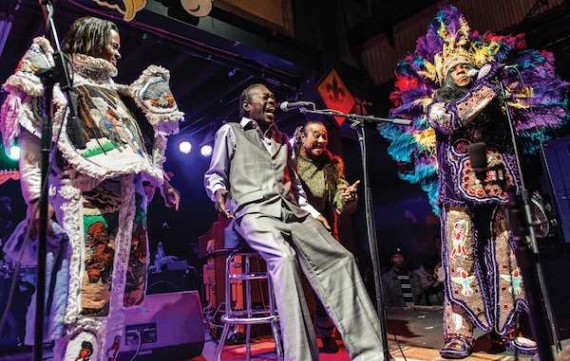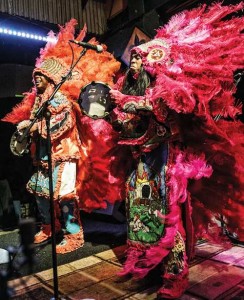
Bo Dollis, Jr. and Sr. with Monk Boudreaux at the Tipitina’s Wild Magnolias reunion. Photo by Golden Richard III.
The rain is pouring down in a grey deluge on a Saturday afternoon in February, pooling so quickly on Louisiana Avenue that the street is filling up with water, turning it into an asphalt bayou. The radio alternates between reports of tornado watches and updates on the status of the day’s big Mardi Gras parade, Endymion. Inside the barber shop and beauty parlor at 1801 Louisiana, all eyes are on the television sets showing Whitney Houston’s funeral on BET. In the beauty shop section, a group of women dressed in their Sunday best watch the four-hour event reverently. An elderly woman sitting in the corner dabs at her tears with a white handkerchief.
Upstairs in the apartment Bo Dollis shares with his wife Rita, Bo sits in his easy chair watching the same ceremony. He’s cozy and comfortable, swaddled in warm clothes and a wool cap, dozing off quietly in between warm greetings from visitors. Dollis has been in failing health since a series of strokes suffered after Katrina, but he’s shown remarkable resilience and his broad smile can still fill the room. Rita has set out the fixings for a Mardi Gras party, but only a few people have battled the weather to get to her place. She cheerfully lays out plates of succulent turkey necks with brown gravy and red beans and rice. Her son Gerard (Bo Dollis, Jr.) periodically comes upstairs to bring plates of food down to the barber shop, where he works as the manager.
On the television, pastor Joe A. Carter of the New Hope Baptist Church is delivering an emotional sermon about Houston. “The life that we lead,” he intones, pausing for emphasis, “is our gift to God.”
The Dollis household is different this year on the weekend before Fat Tuesday. There’s no hurried preparation of Mardi Gras Indian suits: no sewing, no gluing of feathers, no pieces of Indian habiliments in the adjoining workshop of this sprawling house. The rain beats against the roof like a million percussionists, but this year the music of Mardi Gras is stilled. For only the second time since he began masking Indian as a teenager, Bo Dollis will not be marching this Mardi Gras day, and his gang, the Wild Magnolias, will be on the sidelines.
The other year Bo didn’t mask on Fat Tuesday was the year his mother died. “Last year it took so much out of him to get ready that we decided to take this year off,” Gerard says. “But we’ll be out again next year.”
What Gerard, Bo and Rita were planning was a return to the stage of the Wild Magnolias band scheduled for March 10 at Tipitina’s. The event would mark the reunion of Bo Dollis and his childhood friend Monk Boudreaux, a tandem that changed the historic direction of the Mardi Gras Indians a generation ago when they began playing the traditional music backed up by a funk band with arrangements put together by Willie Tee. The Wild Magnolias brought Mardi Gras Indian music from the backyards and street corners of New Orleans neighborhoods to the rest of the world.
With Bo in failing health and Monk in his 60s, there is much speculation about the future of the Mardi Gras Indians. Who will be the leaders of the next generation of Indian gangs? Can what was up until the 1970s essentially a secret society representing the poorest neighborhoods of New Orleans continue its gnostic traditions when those neighborhoods have been depopulated and gentrified? Can this unique cultural heritage maintain its identity even as it’s been popularized by music videos, Jazz Fest and HBO’s Treme?
There are no definitive answers to these questions, just as there is no undisputed official history of the Mardi Gras Indians themselves. Historians look for overview, but the testimony of the Black Indians themselves depends on their circumstances. Though there are proscribed gestures and signs that all the gangs are supposed to adhere to and a common language of songs and chants, each chief tells his own story, a story tailored to the experiences of his neighborhood and his friends. Black Indians give different stories about the meaning and heritage of their tradition based on who taught them the tradition and how they interpret it.
That personalized sense of history has created rifts, though, because the leadership succession has become similarly idiosyncratic in many cases. Many old school Indians complain that the newcomers don’t understand the tradition and are disrespecting it by not learning the proper signals. In one notorious incident, a Big Queen of a venerable tribe punched out a young Queen at an Indian practice when the neophyte didn’t observe the proper protocol. Bertrand Butler, Director of the New Orleans Mardi Gras Indian Council, takes the issue very seriously.
“You got a lot of guys calling themselves chiefs, but you can’t just jump up there and say I’m bringing a new tribe,” says Butler. “You can’t just jump up and put on a suit. Some guys try to do it, but who’s going to respect you? You’ve got to go through the gang. You’ve got to be a spy boy. You’ve got to be a chief scout. You got to know what your doin’ out there because if you give the wrong signal, that’s trouble. You can put on a suit and bring 50 kids, but the other gangs on the street, they ain’t gonna respect you because you don’t know how to play the game. You don’t play the game because you like it. You play it because you know it.
“How can you teach younger people how to be an Indian when you just took on the title and say I’m a chief?” Butler asks. “Where’d you learn to be a chief from? If I put on an Indian suit and call myself a chief, another Indian chief won’t respect me. They’re going to pass me by on Mardi Gras Day like I’m a fresh fish. I’m not your equal. Next day—we’re friends. We talk then, the day before, but not that day.
“A lot of guys can pay somebody to make ‘em a suit. You gotta sew it with your hands. When the Indians sing, ‘Sew all night and sew all day / somebody gotta sew, sew, sew,’ there’s a reason they sing that. You just singing that to be singin’ if somebody else sewed for you. You didn’t put no sweat and blood into that.”
One thing is certain. There are Indian gangs out there and plenty of them. Monk Boudreaux, who Jazz Fest consults on Mardi Gras Indian questions, says there are more Indian tribes today and more public interest in them than ever. “It used to be an exclusively black tradition,” he says. “But now everybody has caught on and it’s gotten bigger.” The Indians have really become popular since Katrina, perhaps in part because so much attention was drawn to the plight of their neighborhoods after they were destroyed by the federal flood.
“The first thing I thought of after Katrina was what’s going to happen to Mardi Gras and the Indians,” recalls Boudreaux’s manager, Rueben Williams. “I realized it was important for Monk to get replanted in New Orleans and things would take their own course. But on the first Mardi Gras Day after Katrina, I would see one chief walking by himself towards Dryades. None of his tribe was back. You kept seeing that over and over.”
But more and more have come back to walk their trails, even if they are no longer living in New Orleans.
“On Mardi Gras and Indian Super Sunday, we see Indians from all over,” says Butler. “We got Chief Peppy—he’s in Texas and he’s going to come to Mardi Gras, he’s going to come to Super Sunday. I know some come down from Nashville. They may not be here during the year, but they’re still sewing in Texas, they’re still sewing in Mississippi, they’re still sewing in California because they got that spirit. Even if you’re away from here, you still talk the Mardi Gras talk. You still talk the neighborhood talk: ‘Man if I was here on Mardi Gras Day….’ Even in prison if you’re from New Orleans, you be saying, ‘This is what we be doing on Mardi Gras Day.’ That spirit goes all over the world. The majority of them make it back if they can afford it.”
This past Mardi Gras, it was impossible to walk around New Orleans without encountering a gang on the move. On my way Uptown to catch the scene at Second and Dryades, I ran across the spyboy from the Black Cherokee gang checking out the situation on St. Claude Avenue as his mauve-hued tribe assembled several blocks up Feliciana Street. People stopped their cars to take his picture, and he unsheathed his feathered wands to reveal a pair of gleaming machetes—ceremonial to be sure, but menacing enough to keep any potential trouble at bay. As I went past Sidney’s on St. Bernard Avenue, a pickup truck and a large moving van discharged another tribe of red-clad Indians into the fray.
Uptown, there were tribes moving all over the area from Napoleon to Jackson Avenue and from Claiborne to St. Charles. Monk Boudreaux, Big Chief of the Golden Eagles, paraded in a vivid, deep purple suit with his son Joseph, Jr. and their gang down from Valence Street over to Second and Dryades with a second line that included Skull and Bones costumed monitors, various New Orleans musicians, including Stanton Moore and Rick Trolsen, and a collection of 15 women dressed as Baby Dolls.
Bo Dollis sat in a wheelchair on the sidewalk just down from Second and Dryades, surveying the scene and greeting well-wishers. Every Indian who came to that meeting place stopped to pay tribute to him. After a few hours of revelry in the brilliant sunlight, Boudreaux began to chant and Joseph led the response. Soon, Boudreaux was traveling up Second followed by his entourage, dancing backwards as he led his followers. As the group approached Washington and Lasalle, you could see gangs converging at the intersection, four in all. The chant of “Indians, here we come” rang out, and just as Monk hit the crossroads, he gave a vivid illustration of the protocol conventions that require old school chiefs to pass the neophytes by. While the other tribes offered various greetings, Monk magically slipped through, turning down the street past the projects and the shuttered Dew Drop Inn. Jimmy Carpenter approached Boudreaux and asked him if he deliberately passed by the other Indians without greeting them.
“I blew all them muthafuckas off,” Monk said with a chuckle. “When I come through, they get outta the way.”
As the group approached Napoleon Avenue, a line of cars and the remains of the Mardi Gras parades obstructed Monk’s path. A fire truck appeared like a roadblock, but Monk and Joseph knew what to do. “Get out the way” they chanted as the drums boomed and the tambourines clattered. The traffic parted like the Red Sea for Moses, and there was Monk, grinning and walking backward, the Uptown Ruler. Joseph led the chants the rest of the way back to Monk’s house, where Boudreaux cooked game meat—rabbits, wild boar, deer, raccoon—for all of his followers.
Monk was giving his son and the other members of his gang a lesson in how to be an Indian on Mardi Gras Day.
“Monk and Bo are good teachers,” says Bertrand Butler. “Anybody who comes under their influence is gonna be a good chief. Gerard (Bo Jr.), you know he’s been seasoned. He’s been out there. He’s young, but he masked with his daddy. He didn’t just pop up and call hisself a chief. He masked for 10 or more years. He might need to know a little more, but he’s going to learn a little more as he goes.”
Other Indian institutions are teaching youngsters how to share in the tradition. Big Chief Howard Miller of the Creole Wild West holds regular classes in Indian culture.
“The Creole Wild West has classes at Davis Park,” says Butler. “The kids in the neighborhood are welcome to come there and visualize what it takes to become a Mardi Gras Indian. They might see an Indian on Mardi Gras Day and say, ‘I like that.’ They have classes for them. Sometimes we have 25, 30 kids there. These kids probably won’t be able to make it on the street because it takes money to finance making the suits. We help as many as we can; the next year we try to help those that we couldn’t help. Hopefully we’ll get some financial support so we can help more. At Chief Howard’s house alone, they got at least five Indian suits for kids. Somewhere else, we got maybe five more from the same gang.”
A month after Mardi Gras, the Wild Magnolias reunion at Tipitina’s did more than Bo and Monk back together after a decade-long separation. It united them with the next generation of Indians—Bo, Jr. and Joseph, Jr.—who teamed up with Irving “Honey” Bannister Jr. of the Creole Wild West. The three new generation Indians opened the show backed by guitarist Billy Iuso and the Restless Natives, and they were soon joined by Monk Boudreaux. The Magnolias kept building the intensity until Bo came out to deliver “Cabbage Alley” and the show hit its peak.
Dollis was only on stage for a limited time, but he touched eternal truth while he was there. With any luck we’ll get to see him do this again at Jazz Fest and beyond.
There will never be another Bo Dollis or Monk Boudreaux, just as there will never be another Muddy Waters, Otis Redding or James Brown. But it seems certain that the culture of the Mardi Gras Indians will continue to draw from the spiritual wellspring that inspired Bo and Monk. Change is inevitable, and just as Bo and Monk changed the direction and perception of their culture, those that follow will add their personalities to the mix. There is added encouragement in the fact that Butler and the Indian Council have had some success this year in combating the relentless oppression visited on the Indians by the New Orleans Police Department. Mardi Gras, then Super Sunday went by without incident as Indians gathered and practiced their rituals under the inspirational slogan, “You cannot police a bird.”
Big Chief Monk Boudreaux & the Golden Eagles play Jazz Fest on Sunday, April 29 at 4:30 p.m. on the Jazz & Heritage Stage.
Bo Dollis & the Wild Magnolias play Jazz Fest on Sunday, May 6 at 4:25 p.m. on the Jazz & Heritage Stage.





